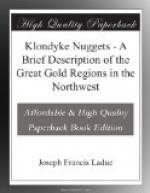“Just below the Big Salmon the Lewes takes a bend of nearly a right angle. Its course from the junction with the Tahkeena to this point is generally a little east of north; at this point it turns to nearly west for some distance. Its course between here and its confluence with the Pelly is north-west, and, I may add, it preserves this general direction down to the confluence with the Porcupine. The river also changes in another respect; it is generally wider, and often expands into what might be called lakes, in which are islands. Some of the lakes are of considerable length, and well timbered.
“To determine which channel is the main one, that is, which carries the greatest volume of water, or is best available for the purposes of navigation, among these islands, would require more time than I could devote to it on my way down; consequently I cannot say more than that I have no reason to doubt that a channel giving six feet or more of water could easily be found. Whenever, in the main channel, I had reason to think the water shallow, I tried it with my paddle, but always failed to find bottom, which gives upward of six feet. Of course I often found less than this, but not in what I considered the main channel.
“Thirty-six and a quarter miles below the Big Salmon, the Little Salmon—the Daly of Schwatka—enters the Lewes. This river is about 60 yards wide at the mouth, and not more than two or three feet in depth. The water is clear and of a brownish hue; there is not much current at the mouth, nor as far as can be seen up the stream. The valley which, from the mouth, does not appear extensive, bears north-east for some distance, when it appears to turn more to the east. Six or seven miles up, and apparently on the north side, some high cliffs of red rock, apparently granite, can be seen. It is said that some miners have prospected this stream, but I could learn nothing definite about it.
“Lewes River makes a turn here to the south-west, and runs in that direction six miles, when it again turns to the north-west for seven miles, and then makes a short, sharp turn to the south and west around a low sandy point, which will, at some day in the near future, be cut through by the current, which will shorten the river three or four miles.
“Eight miles below Little Salmon River, a large rock called the Eagle’s Nest, stands up in a gravel slope on the easterly bank of the river. It rises about five hundred feet above the river, and is composed of a light gray stone. What the character of this rock is I could not observe, as I saw it only from the river, which is about a quarter of a mile distant. On the westerly side of the river there are two or three other isolated masses of apparently the same kind of rock. One of them might be appropriately called a mountain; it is south-west from the Eagle’s Nest and distant from it about three miles.
“Thirty-two miles below Eagle’s Nest Rock, Nordenskiold River enters from the west. It is an unimportant stream, being not more than one hundred and twenty feet wide at the mouth, and only a few inches deep. The valley, as far as can be seen, is not extensive, and, being very crooked, it is hard to tell what its general direction is.




